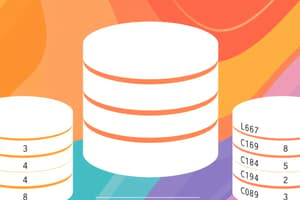Podcast
Questions and Answers
Which type of normalization eliminates insertion, update, and deletion anomalies?
Which type of normalization eliminates insertion, update, and deletion anomalies?
- 3NF (correct)
- 4NF
- 1NF
- 2NF
What is one of the advantages of normalization related to data structure?
What is one of the advantages of normalization related to data structure?
- Inflexible data structure
- More efficient data structure (correct)
- Complex data structure
- Increased redundancy in data structure
Which advantage of normalization ensures that distinct tables exist when necessary?
Which advantage of normalization ensures that distinct tables exist when necessary?
- Better understanding of data
- Minimization of data duplication (correct)
- Avoidance of redundant fields or columns
- Close modeling of real world entities
What does normalization help in maintaining related to data structure?
What does normalization help in maintaining related to data structure?
Which type of normalization puts data into tabular form by removing duplicated data from relation tables?
Which type of normalization puts data into tabular form by removing duplicated data from relation tables?
In the relation Employee(Emp_Id, Emp_Name, Emp_Address), which functional dependency can be represented?
In the relation Employee(Emp_Id, Emp_Name, Emp_Address), which functional dependency can be represented?
In the context of functional dependency, what does it mean when attribute X functionally determines attribute Y in a relation?
In the context of functional dependency, what does it mean when attribute X functionally determines attribute Y in a relation?
If a relation has a functional dependency X $\rightarrow$ Y, what can be inferred about the values of Y?
If a relation has a functional dependency X $\rightarrow$ Y, what can be inferred about the values of Y?
In the context of functional dependency, what does it mean if attribute X is not functionally dependent on attribute Y?
In the context of functional dependency, what does it mean if attribute X is not functionally dependent on attribute Y?
Flashcards are hidden until you start studying
Study Notes
Normalization
- BCNF (Boyce-Codd Normal Form) normalization eliminates insertion, update, and deletion anomalies.
- One of the advantages of normalization related to data structure is minimizing data redundancy.
Data Structure
- Normalization ensures that distinct tables exist when necessary, which is an advantage of avoiding data redundancy.
- Normalization helps in maintaining data integrity by reducing data redundancy and improving data consistency.
Types of Normalization
- 1NF (First Normal Form) normalization puts data into tabular form by removing duplicated data from relation tables.
Functional Dependency
- In the relation Employee(Emp_Id, Emp_Name, Emp_Address), the functional dependency Emp_Id → Emp_Name and Emp_Id → Emp_Address can be represented, meaning Emp_Id determines Emp_Name and Emp_Address.
- If attribute X functionally determines attribute Y in a relation, it means that the value of Y is determined by the value of X.
- If a relation has a functional dependency X → Y, it can be inferred that the value of Y is dependent on the value of X.
- If attribute X is not functionally dependent on attribute Y, it means that the value of Y is not determined by the value of X.
Studying That Suits You
Use AI to generate personalized quizzes and flashcards to suit your learning preferences.




